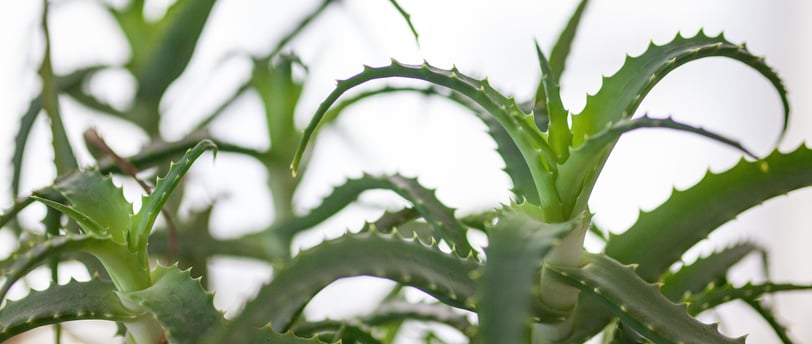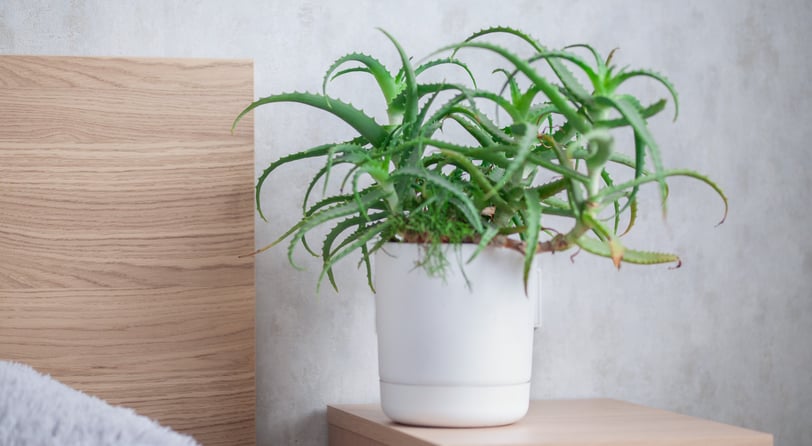Aloe arborescens or Oželis?
Aloe Arborescens Miller
Dalia Šateikienė
2/3/20254 min read


It so happened that during the winter, my daughter developed a persistent cough. When it didn’t go away, I took her to our family doctor. At the appointment, the doctor listened to her lungs, found nothing concerning, and then asked me:
"Do you have an oželis at home?"
"A what?" I asked, confused. Even though we live in the countryside, we don’t have a farm.
The doctor laughed and said, “You know, the one that grows on the windowsill.”
"You mean an aloe?" I clarified.
"Yes, the one our grandmothers used to call alijošius."
I nodded—yes, we had one at home.
"Then make a cough syrup: mix equal parts of honey and the colorless gel from an oželis leaf, store it in the fridge, and take a teaspoon in the morning and evening."
That was my first introduction to the folk name for aloe.
And since I just recalled what the doctor called oželis, today I want to introduce the first member of the Aloe family—the one most commonly found on Lithuanian windowsills: Aloe arborescens Mill., also known in Lithuanian as medėjantis alavijas (tree-like aloe).
Characteristics of Aloe arborescens
This plant naturally grows in South Africa. It has fleshy leaves with spiky edges and thrives in bright indoor spaces. In summer, it needs abundant watering, while in winter, it should be watered sparingly. It propagates easily through side shoots and cuttings.
If we compare its appearance to the well-known Aloe vera, the first noticeable difference is that Aloe arborescens has smaller leaves that grow along a stem, which eventually becomes woody—hence its name medėjantis alavijas (tree-like aloe). Meanwhile, Aloe vera leaves form a rosette and are two to three times thicker. When an Aloe vera leaf is cut, a yellowish latex starts oozing out, which can irritate the skin and has a distinctive smell (which I personally dislike, so I don’t use it for making juice). In contrast, when you cut Aloe arborescens, you’ll see only a sticky, colorless liquid that has no noticeable scent.
Using Aloe arborescens
In Russian literature, I found a recommendation to store cut leaves in a bag in the refrigerator. After two weeks, any blackened leaves should be discarded, while the rest can be used for juicing. This process is said to enhance the plant's medicinal properties. However, I must note that refrigerated aloe leaves are not recommended for cancer patients, as they stimulate the immune system, making only freshly cut leaves suitable for them.
I’ve personally tried using Aloe arborescens gel as a skin moisturizer, but I was disappointed—it dried out my skin and made it feel tight. On the other hand, Aloe vera gel (after removing the latex) works wonderfully for both my skin and hair, as well as for my children.
That said, the gel from Aloe arborescens leaves is recommended for daily consumption—especially for people with diabetes—as it helps regulate blood sugar levels and supports immunity.
If you peel off the bitter green part of the leaf, the remaining gel is tasteless and easy to chew. However, in the past, our grandmothers would chew the entire leaf straight from the plant.
Before harvesting leaves, it's advised to avoid watering the plant for at least a week. This helps concentrate beneficial compounds and reduce excess water content.
Important Considerations
Before consuming Aloe arborescens gel, I strongly recommend consulting a doctor, as the leaves contain high levels of potassium, which some people need to limit.
Different Aloe species have varying amounts of active compounds. Compared to Aloe vera, Aloe arborescens has a higher concentration of beneficial substances and is considered more potent. This is why Aloe arborescens, or oželis in folk terminology, is stronger in effect than Aloe vera. However, due to its smaller leaves and lower yield, it is less commercially viable.
Growing and Decorative Use
I’ve noticed that Aloe arborescens thrives in a greenhouse during the summer—it grows vigorously in that environment.
It can also be shaped into a bonsai tree because its stem becomes woody and it produces lateral shoots. It grows faster than traditional bonsai trees, meaning you can see results in a shorter time.
In its natural habitat, Aloe arborescens can grow up to three meters tall.
If you plan to consume parts of the plant, I don't recommend growing it in the kitchen. Since it purifies the air, it can accumulate harmful substances, which you wouldn’t want to ingest.
You can also check the air quality in your home by observing your aloe leaves. If black spots appear on them, it’s a sign of pollution—those leaves should not be used for food.
Compared to other aloes, Aloe arborescens is less demanding in terms of light and can survive winters even a bit further from a window. This is why I often use it as a decorative element in my home.
Final Thoughts
This beloved plant, cherished by our grandmothers, is not only a great health aid but also a beautiful addition to any home. While it may not be a universal remedy, if you have a bright, sunny spot in your home, oželis is definitely worth growing—it’s an undemanding yet valuable companion.



